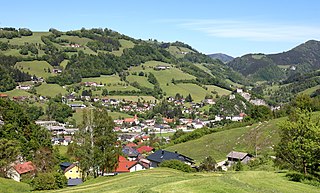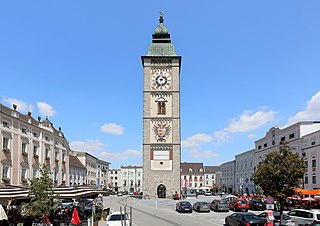
Lower Austria is one of the nine states of Austria, located in the northeastern corner of the country. Major cities are Amstetten, Krems an der Donau, Wiener Neustadt and Sankt Pölten, which has been the capital of Lower Austria since 1986, replacing Vienna, which became a separate state in 1921. With a land area of 19,186 km2 (7,408 sq mi) and a population of 1.7 million people, Lower Austria is the largest and second-most-populous state in Austria.

Steyr is a statutory city, located in the Austrian federal state of Upper Austria. It is the administrative capital, though not part of Steyr-Land District. Steyr is Austria's 12th most populated town and the 3rd largest city in Upper Austria.

Losenstein is a small village in the south of Upper Austria, Austria. About 1,700 inhabitants call Losenstein their home. It lies in the southernmost quarter of Upper Austria called "Traunviertel". Its spatial dimension from North to South is 8,1 km, from West to East 4,5 km. 45,9% of its area are covered by forests, another 39,7% are used for agricultural purposes. The closest city of administrative importance is Steyr, which is 20 km to North. It can be accessed via the "B-109 Eisenbundesstrasse" or by train.

Enns is a town in the Austrian state of Upper Austria on the river Enns, which forms the border with the state of Lower Austria.

Dürnstein is a small town on the Danube river in the Krems-Land district, in the Austrian state of Lower Austria. It is one of the most-visited tourist destinations in the Wachau region and also a well-known wine growing area. The municipality consists of the Katastralgemeinden of Dürnstein, Oberloiben, and Unterloiben.

Regau is a municipality in the Austrian state of Upper Austria near Vöcklabruck, which is the capital of the district.
Bezirk Kirchdorf is a district of the state of Upper Austria in Austria.

Molln is a municipality in the district of Kirchdorf an der Krems in the Austrian state of Upper Austria. It is remembered as a place where there was a poacher battle in 1919 and four people were shot and killed.

Reichenau is a municipality in the district of Feldkirchen in the Austrian state of Carinthia.

Krems in Kärnten is a municipality in the district of Spittal an der Drau in Carinthia in Austria.
Voitsberg is a small city in the district of Voitsberg in Styria, Austria, with a population of c. 9,400 as of 2018. It grew upon the St. Margaret church at the Tregistbach river and was first mentioned in 1220 as Civitas. Remains of the Greisenegg palace and Obervoitsberg castle can be seen. Other objects of interest are its Cityhall Voitsberg, designed by architect Arik Brauer.

Hinterstoder is a municipality in the district of Kirchdorf an der Krems in Upper Austria, Austria. The village is located close on the border to the federal state Styria and 600 m above sea level. Hinterstoder is surrounded by several mountains: Grosser Priel, Kleiner Priel, Spitzmauer and Warscheneck.

Rohr im Kremstal is a municipality in the district of Steyr-Land in the Austrian state of Upper Austria.

Ternberg is a municipality in the district of Steyr-Land in the Austrian state of Upper Austria.

Waldneukirchen is a municipality in the district of Steyr-Land in the Austrian state of Upper Austria.

The Steyr Valley Railway was a 760 mm narrow gauge railway in Upper Austria, which ran along the valley of the River Steyr from Garsten through Steyr, Grünburg and Molln to Klaus, with a branchline to Sierning and Bad Hall. A section of the line has been retained as a museum railway.
Stainach-Pürgg is a municipality since 2015 in the Liezen District of Styria, Austria.

The Pyhrn railway line is a railway line in Upper Austria. It runs 104.2 kilometres (64.7 mi) from Linz Hauptbahnhof, where it connects with the Western railway line, to Selzthal, where it connects with the Enns Valley Railway and Rudolf Railway. The line takes its name from the Pyhrn Pass through which it runs.


















